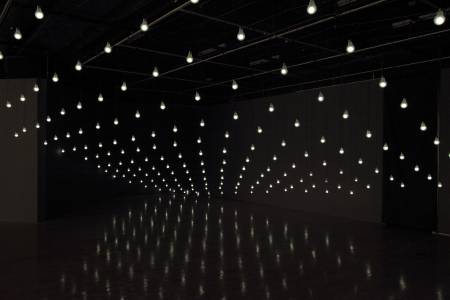This review is published under Dundee University Review of the Arts. It can be found at: http://dura-dundee.org.uk/indirect-imaging/
The renowned American artist Jim Campbell presents his first solo exhibition in the UK this winter with Indirect Imaging. After studying Mathematics and Engineering at MIT in the 1970’s, Jim Campbell has since worked in filmmaking, interactive video and LED light technology. His work is in the collections of major museums including the MoMA, the Whitney Museum of American Art and many more. It is a great delight to be able to see the genius of his work first hand in the ever-growing contemporary art scene within Dundee. Campbell constructs magical light sculptures using low resolution home movies and light installations. His light sculptures are made using LEDs, the images portrayed in them being derived from the movement within the films he uses where he decreases the resolution of these simple home movies drastically to keep recognisable visual information to a minimum.
Dimly lit, the only sources of light within Indirect Imaging are from the works themselves. This  focuses attention on the works themselves in all of their detail. The use of LEDs in connection with moving images creates a series of abstractions, which in turn create a sense of other worldliness. Jim Campbell’s use of LED lighting to create low-resolution images is further a subversion of the high-resolution ‘technological era’ that we live in today. His low-resolution imaging creates something more timeless: more aesthetic and less anchored in the everyday.
focuses attention on the works themselves in all of their detail. The use of LEDs in connection with moving images creates a series of abstractions, which in turn create a sense of other worldliness. Jim Campbell’s use of LED lighting to create low-resolution images is further a subversion of the high-resolution ‘technological era’ that we live in today. His low-resolution imaging creates something more timeless: more aesthetic and less anchored in the everyday.
 From a small rectangular black velvet panel to a full room installation, the size and scale of the works in Indirect Imaging differ immensely. Indeed, Tilted Plane is in fact one of the largest scale works ever to be installed in the galleries of DCA. It is the scale and also the ability of the viewer to walk into the installation – to see it from another perspective – which compels the viewer to engage with the work completely. Tilted Plane also relies on reflection: the hundreds of lights hung from the ceiling are reflected upon the floor create an immense spatial depth.
From a small rectangular black velvet panel to a full room installation, the size and scale of the works in Indirect Imaging differ immensely. Indeed, Tilted Plane is in fact one of the largest scale works ever to be installed in the galleries of DCA. It is the scale and also the ability of the viewer to walk into the installation – to see it from another perspective – which compels the viewer to engage with the work completely. Tilted Plane also relies on reflection: the hundreds of lights hung from the ceiling are reflected upon the floor create an immense spatial depth.
Perhaps the most thought-provoking work is Last Day in the Beginning of March. This work draws on the last day of the life of Jim Campbell’s brother. Twenty-six lights are suspended from the ceiling,  each creating a circular pool of light on the floor. Around the walls are mounted and illuminated fragments of text representing a memory or an event. The addition of an audio recording of rain completes this installation and evokes an overwhelming sensation of melancholy. The incessant rain and the continuous flux of lights accentuate the quality of the mood ; the focus on small textual fragments, the details in the text of “Windshield Wipers”, “Driving”, and “Raining”, give an importance to the things which at the time might seem mere trivialities.
each creating a circular pool of light on the floor. Around the walls are mounted and illuminated fragments of text representing a memory or an event. The addition of an audio recording of rain completes this installation and evokes an overwhelming sensation of melancholy. The incessant rain and the continuous flux of lights accentuate the quality of the mood ; the focus on small textual fragments, the details in the text of “Windshield Wipers”, “Driving”, and “Raining”, give an importance to the things which at the time might seem mere trivialities.
Overall, this exhibition exceeds expectations; the attention to detail, both within Jim Campbell’s works and its curation, has created an exhibition which is exceptional and original.
Fiona Morag McKinnon
